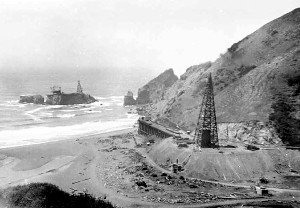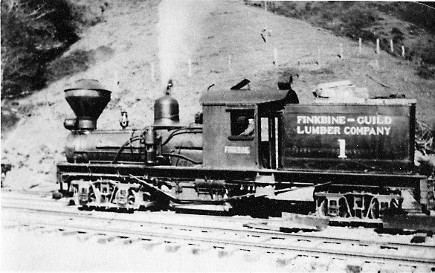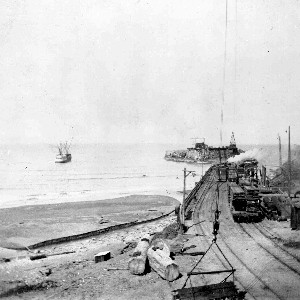|
|
| |
Finkbine-Guild
Company |
The
four most dangerous words in investing are "This
time it's different." |
| |
Sir John
Templeton (1912 - ) |
|
|
|
 Finkbine-Guild
Lumber Company (1925-1927) had made ambitious plans for
Rockport. A copy of a preliminary report from their title
insurance company, dated September 1, 1925, states that
Finkbine-Guild is seeking a loan for $2,225,000 "to
complete the purchase of timberlands and for the building
of a manufacturing plant at Rockport, California" (Rockport
Records, ctn 4, folder 7-1).
This sizable mortgage was to be secured by "approximately
29,278.60 acres estimated by James D. Lacey and Company
to carry virgin timber in the amount of 1,080,344,000 feet,
of which 84% is redwood, and 16% Douglas fir and by sawmills,
loading facilities, dwellings and other operating improvements
now being placed on the lands at a cost of more than $1,000,000"
(ibid). A deed of trust required re-payment of the loan
in ten installments of $225,000 plus interest, beginning
September 1, 1927 and ending September 1, 1936. Finkbine-Guild
Lumber Company (1925-1927) had made ambitious plans for
Rockport. A copy of a preliminary report from their title
insurance company, dated September 1, 1925, states that
Finkbine-Guild is seeking a loan for $2,225,000 "to
complete the purchase of timberlands and for the building
of a manufacturing plant at Rockport, California" (Rockport
Records, ctn 4, folder 7-1).
This sizable mortgage was to be secured by "approximately
29,278.60 acres estimated by James D. Lacey and Company
to carry virgin timber in the amount of 1,080,344,000 feet,
of which 84% is redwood, and 16% Douglas fir and by sawmills,
loading facilities, dwellings and other operating improvements
now being placed on the lands at a cost of more than $1,000,000"
(ibid). A deed of trust required re-payment of the loan
in ten installments of $225,000 plus interest, beginning
September 1, 1927 and ending September 1, 1936.
Finkbine-Guild
had been successful at operating southern pine mills in
Mississippi. After exhaustion of their Mississippi timberlands,
they planned to keep their mills as re-manufacturing and
finishing plants and feed them with California redwood.With
headquarters in Jackson, Mississippi, the Finkbine-Guild
Lumber Company bought the Cottoneva Lumber Company, dormant
for 15 years, in 1925. The officers of the company at that
time were W. E. Guild, president; W. O. Finkbine, vice-president;
R. H. Finkbine, vice-president; H. M. Finkbine, vice-president;
R. G. Berry, treasurer; and C. E. Klumb, Secretary.
 The
new owners constructed a sawmill, logging railroads, and
loading facilities, including redwood towers and a cable
system, powered by a steam engine, to sling logs from shore
to the "island rock" and then onto ships—the
Frank B. Stout, the Bertie M. Hanlon,
the Florence Olson, and the Necanicum.
Because of the remote location, Finkbine-Guild built the
first modern family homes at Rockport and introduced many
new services, including a company store, a mess hall, a
hotel, a barber shop, and an emergency hospital with a doctor
in attendance. Since 35 families were now living at Rockport,
there was also a school with two teachers for the 60 children
registered to attend. One of the teachers was Miss DeVilbiss,
a well-known family name at that time in the Rockport area.
Benefits for the sawmill workers, however, did not necessarily
include national holidays. A notation in the Finkbine-Guild
files from Joe Alexander, the company general manager, says:
"Did not shut down for Thanksgiving, but I am giving
the crews a turkey dinner tonight" (Rockport Records,
ctn 19, folder 59-27, research paper presumably by Edgar
L. Stetson from Sacramento State College on Finkbine-Guild
Lumber Company, p. 18). The
new owners constructed a sawmill, logging railroads, and
loading facilities, including redwood towers and a cable
system, powered by a steam engine, to sling logs from shore
to the "island rock" and then onto ships—the
Frank B. Stout, the Bertie M. Hanlon,
the Florence Olson, and the Necanicum.
Because of the remote location, Finkbine-Guild built the
first modern family homes at Rockport and introduced many
new services, including a company store, a mess hall, a
hotel, a barber shop, and an emergency hospital with a doctor
in attendance. Since 35 families were now living at Rockport,
there was also a school with two teachers for the 60 children
registered to attend. One of the teachers was Miss DeVilbiss,
a well-known family name at that time in the Rockport area.
Benefits for the sawmill workers, however, did not necessarily
include national holidays. A notation in the Finkbine-Guild
files from Joe Alexander, the company general manager, says:
"Did not shut down for Thanksgiving, but I am giving
the crews a turkey dinner tonight" (Rockport Records,
ctn 19, folder 59-27, research paper presumably by Edgar
L. Stetson from Sacramento State College on Finkbine-Guild
Lumber Company, p. 18).
In an age before email,
faxes, and even reliable phone lines, W. E. Guild, company
president, and Joe Alexander exchanged letters daily. Were
someone to analyze those letters, we would have an excellent
picture of the day-to-day workings of the company and the
difficulties a manager had coping with the problems of a
remote location and remote company executives. Daily problems
included broken turbines, broken cable lines, bad weather,
blocked roads, difficulties in getting materials and groceries,
and, of course, labor issues. Guild usually addressed Alexander
as "Dear Joe" or just "Friend Joe."
Guild writes to Alexander on 20 January 1927, blaming his
delayed response on endless meetings and encouraging Alexander
to keep the lumber schooners sailing on schedule:
I think possibly
you think you have been forgotten and left to fight
your battles alone, which I know are numerous and
most perplexing, but such is not the case, Joe,
I can assure you. I received your different letters
sent to Des Moines and I read the same carefully.
I was unable to answer them, Joe, for the reason
every moment from the time I arrived there Monday
morning until late Tuesday night was taken up. We
had so many meetings to get through with in such
a short time. ..I
judge...you are still having trouble and I know
how exasperating it is, Joe, and how trying it is,
but I suppose one of these day these things will
be overcome and we will then forget the troubles
we have been through.
I also note the
weather you have been having and the serious condition
you are in on account of the road being blocked
between Rockport and Ft. Bragg. It does seem as
if the County should keep these roads open when
they are collecting taxes from the property owners
and their transportation to and from their properties
depends on the keeping open of these roads. While
I know we have no way of forcing them
to do it, it does seem as if it should be done.
It looks as if we were going to have a very hard
trying winter out there and undoubtedly the roads
will get worse instead of better, but if we can
only have regular sailings of the boats we can keep
our supplies on hand and keep going just the same.
They should in some way be able to keep open the
telephone lines so you could have constant communication
with the outside world by telephone at least and
also the mails should come and go regularly in some
manner. (Rockport Records, ctn 18, folder 58-1)
|
 All
the redwood logged at Rockport was destined for Gulfport,
Mississippi. Finkbine-Guild spent considerable money building
a dock and loading facilities in San Francisco Bay near
Sausalito. From there, logs would be transferred to one
of the company's oil-burning ships: the Abron, Dochet, Manhattan
Island, Sabatowan, and Dio ((Rockport Records, ctn 19, folder
59-27, Finkbine-Guild Lumber Company, p. 13 -14).
Four were purchased on November 20, 1925 and the last on
February 10, 1926 (ibid). Together they were called The
Redwood Line. The ships steamed from San Francisco
Bay through the Panama Canal to Gulport, Mississippi. At
Gulfport, the ships were unloaded and logs were put onto
railroad flat cars for the trip to D'Lo, Mississippi. It
was at D'Lo that the logs were processed into finished lumber.
Rockport mill only produced cants—unbarked logs that
are roughly cut into several pieces for later re-manufacturing.
There were no planers to produce finished lumber. According
to one researcher with access to the Finkbine-Guild records,
the sawmill at D'Lo received 12,344, 022 board feet of lumber
during the first 9 months of 1927—less than anticipated
(ibid, p. 15). In 1927, redwood lumber prices at D'Lo ranged
from $45-$100 per 1000 board feet (ibid). All
the redwood logged at Rockport was destined for Gulfport,
Mississippi. Finkbine-Guild spent considerable money building
a dock and loading facilities in San Francisco Bay near
Sausalito. From there, logs would be transferred to one
of the company's oil-burning ships: the Abron, Dochet, Manhattan
Island, Sabatowan, and Dio ((Rockport Records, ctn 19, folder
59-27, Finkbine-Guild Lumber Company, p. 13 -14).
Four were purchased on November 20, 1925 and the last on
February 10, 1926 (ibid). Together they were called The
Redwood Line. The ships steamed from San Francisco
Bay through the Panama Canal to Gulport, Mississippi. At
Gulfport, the ships were unloaded and logs were put onto
railroad flat cars for the trip to D'Lo, Mississippi. It
was at D'Lo that the logs were processed into finished lumber.
Rockport mill only produced cants—unbarked logs that
are roughly cut into several pieces for later re-manufacturing.
There were no planers to produce finished lumber. According
to one researcher with access to the Finkbine-Guild records,
the sawmill at D'Lo received 12,344, 022 board feet of lumber
during the first 9 months of 1927—less than anticipated
(ibid, p. 15). In 1927, redwood lumber prices at D'Lo ranged
from $45-$100 per 1000 board feet (ibid).
Money and technology do
not guarantee success, as any CEO or general can attest.
The opportunities for project failure are legion. By 1927,
nothing could stop the corporate bleeding at Finkbine Guild,
including a top-level shakeup that resulted in E. C. Finkbine
as president; W. O. Finkbine, vice-president; and W. E.
Guild, treasurer and general manager. Within two years of
operation, the Finkbine-Guild Lumber Company was broke.
Despite the fact that Finkbine-Guild Lumber Company was
the first electric-powered sawmill in Mendocino County—the
most technologically innovative sawmill on the Redwood Coast—it
has been called a "magnificent failure"
(Rockport Records, ctn 19,
folder 58-24, Letter of Bernie Agrons to Elwood R. Maunder,
Foest History Society, 12 August 1963). The ultimate failure
of Finkbine-Guild is a lesson in Business 101 and the bottom
line. They could not compete because they were bearing extra
handling costs that local redwood companies did not have.
From here on out, the story
of Finkbine-Guild becomes more complicated. A letter from
the Mendocino County Title Company on December 30, 1929
confirms that all the lands acquired by Finkbine-Guild were
deeded to Southern Redwood Company on July 1, 1928 (Rockport
Records,ctn 4, folder 7-1). The arrangement between Finkbine-Guild
and Southern Redwood Company has been called variously a
"re-organization" and a "merger" to
continue operations at Rockport. Documents do show that
Southern Redwood Company took out a second mortgage on the
Rockport property from Great Southern Lumber Company on
August 27, 1929. Whatever the relationship between Finkbine-Guild
and Southern Redwood Company was, Finkbine-Guild ended it
when they defaulted on the Rockport property's first mortgage
on September 1, 1929. The total amount of the obligation
had been $2,225,000. Prior to the default, $450,000 had
been paid, leaving the default at $1,800,000 (Rockport Records,
ctn 19, folder 59-30, "Cottoneva Redwood Company"
Prospectus).
In Case #11508 before the Superior Court of the State of
California, E. T. Dusenbury, as trustee of Cottoneva Lumber
Company, foreclosed on the Finkbine-Guild mortgage on May
1, 1931. On January 14, 1933, Dusenbury transferred title
of the property to the newly chartered Cottaneva Redwood
Company (Rockport Records, ctn 19, folder 59-30, "Cottoneva
Redwood Company" Prospectus).
|
|
|
| Photo
Credits
Rockport towers (1925), Robert
J. Lee Collection (Ukiah, CA).
Rockport rail line and lumber
"sling", Robert J. Lee Collection (Ukiah, CA).
Finkbine-Guild Shay Engine
#1, Mendocino County Museum (Willits, CA).
Primary Sources
Rockport Redwood Company Records,
BANC MSS 70/184 c, The Bancroft Library (Berkeley, California).
|
 | |
|
 |
|
 | |
|
|